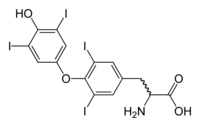
Photo from wikipedia
We read with interest the letter of Gonzalez-Velazquez et al. [1], which raises criticisms regarding our paper on levothyroxine requirements in children with acquired hypothyroidism of different etiologies [2]. This… Click to show full abstract
We read with interest the letter of Gonzalez-Velazquez et al. [1], which raises criticisms regarding our paper on levothyroxine requirements in children with acquired hypothyroidism of different etiologies [2]. This letter offered us the opportunity to clarify some aspects of our research that we were not able to fit in a research letter due to insufficient space. Firstly, we can now explain that all our patients with central hypothyroidism (CeH) checked at least one time during follow-up antithyroid autoantibodies and were negative. Moreover, all the six patients that underwent radiotherapy performed periodically thyroid ultrasound scans during their follow-up excluding an echogenic pattern suggestive for Hashimoto’s thyroiditis (HT). Nonetheless, we disagree with Gonzalez-Velazquez et al., which assert that a hypothetically pre-existence of autoimmune thyroiditis in children with CeH could skew the results of our study. We believe indeed that this eventuality could hypothetically reduce the differences of levothyroxine requirement between the two groups instead of accentuating them. Secondly, Gonzalez-Velazquez et al. assume that it is not possible to compare CeH and HT groups due to the use of FT4 values and TSH values to define treatment target goal. We are aware that our study presented several limitations, related in part to the retrospective design and to the difficulties to compare groups of patients with different etiology of hypothyroidism, and consequently managed with different therapeutic approach. Nevertheless, we believe that our study represents a valid contribution to the knowledge about the treatment of pediatric patients due to the few data available on this topic. ROC curve in our study was not performed with the intent of identifying a cut-off value for differentiate two conditions, i.e., CeHand HT-related hypothyroidism, which diagnosis was a priori clearly defined. Nevertheless, from a statistical point of view, appropriateness of ROC curve for our analysis was guaranteed by the high value of AUC, which was greater than 70% in each year of treatment. Gonzalez-Velazquez et al. criticize us for not having correctly defined clinical euthyroidism and affirm that this was a goal of therapy in our study. We would like to underline again that our study was retrospective, including patients with specific criteria already explained [2]. We are aware that signs and symptoms of hypothyroidism, such as fatigue, constipation, cold intolerance, poor growth, are highly variable among individuals and do not necessarily correlate with the degree of biochemical hypothyroidism [3]. We did not report in our study the definition of clinical euthyroidism or clinical hypothyroidism for absence of space. Moreover, we know that no concrete measures can definitively attributed slowed growth and development to hypothyroidism rather than organic disorders [1]. Therefore, as affirmed by Wassner, any clinical suspicion of hypothyroidism in a child should prompt laboratory testing of thyroid function [3]. However, we would like to specify that, in our study, patients with coexistence of HT and celiac disease were excluded. Finally, we perfectly agree with Gonzalez-Velasquez et al. that treatment for hypothyroidism in children might have more than just one target and that T3 hormone levels are in specific cases useful. However, during hypothyroidism, changes in thyroid hormone metabolism serve to * Tommaso Aversa [email protected]
Journal Title: Endocrine
Year Published: 2020
Link to full text (if available)
Share on Social Media: Sign Up to like & get
recommendations!